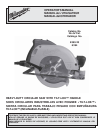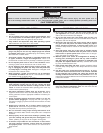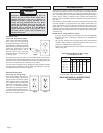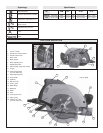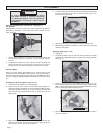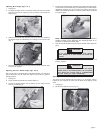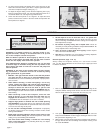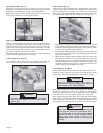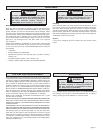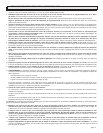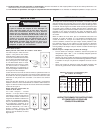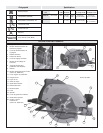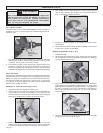
page 3
1. Maintain labels and nameplates. These carry important informa-
tion. If unreadable or missing, contact a MILWAUKEE service facility
for a free replacement.
2. DANGER! Keep hands away from cutting area and blade. Keep
your second hand on auxiliary handle or motor housing. If
both hands are holding the saw, they cannot be cut by the blade.
Do not reach underneath the workpiece. The guard cannot pro-
tect you from the blade below the workpiece.
Adjust the cutting depth to the thickness of the workpiece.
Less than a full tooth of the blade teeth should be visible below the
workpiece.
3. Check lower guard for proper closing before each use. Do
not operate the saw if lower guard does not move freely and
close instantly. Never clamp or tie the lower guard into the open
position. If saw is accidentally dropped, lower guard may be bent.
Raise the lower guard with the retracting handle and make sure it
moves freely and does not touch the blade or any other part, in all
angles and depths of cut.
4. Check the operation and condition of the lower guard spring.
If the guard and the spring are not operating properly, they
must be serviced before use. Lower guard may operate slug-
gishly due to damaged parts, gummy deposits, or a buildup of debris.
5. Lower guard should be retracted manually only for special
cuts such as "Plunge Cuts" and "Compound Cuts". Raise
lower guard by retracting handle and as soon as blade en-
ters the material, the lower guard must be released. For all
other sawing, the lower guard should operate automatically.
6. Always observe that the lower guard is covering the blade
before placing saw down on bench or floor. An unprotected,
coasting blade will cause the saw to walk backwards, cutting what-
ever is in its path. Be aware of the time it takes for the blade to stop
after switch is released.
7. NEVER hold piece being cut in your hands or across your leg.
Secure the workpiece to a stable platform. It is important to
support the work properly to minimize body exposure, blade binding,
or loss of control.
8. Hold power tools by insulated gripping surfaces when per-
forming an operation where the cutting tool may contact hid-
den wiring or its own cord. Contact with a "live" wire will make
exposed metal parts of the tool "live" and shock the operator.
9. When ripping always use a rip fence or straight edge guide.
This improves the accuracy of cut and reduces the chance for blade
binding.
SPECIFIC SAFETY RULES — CIRCULAR SAWS
10. Always use blades with correct size and shape (diamond vs.
round) arbor holes. Blades that do not match the mounting hard-
ware of the saw will run eccentrically, causing loss of control.
11. Never use damaged or incorrect blade washers or bolts. The
blade washers and bolts were specially designed for your saw, for
optimum performance and safety of operation.
12. WARNING! Some dust created by power sanding, sawing, grinding,
drilling, and other construction activities contains chemicals known to
cause cancer, birth defects or other reproductive harm. Some ex-
amples of these chemicals are:
• lead from lead-based paint
• crystalline silica from bricks and cement and other masonry
products, and
• arsenic and chromium from chemically-treated lumber.
Your risk from these exposures varies, depending on how often you
do this type of work. To reduce your exposure to these chemicals:
work in a well ventilated area, and work with approved safety equip-
ment, such as those dust masks that are specifically designed to filter
out microscopic particles.
13. Causes and Operator Prevention of KICKBACK:
KICKBACK is a sudden reaction to a pinched, bound or misaligned
saw blade, causing an uncontrolled saw to lift up and out of the
workpiece toward the operator.
When the blade is pinched or bound tightly by the kerf closing down,
the blade stalls and the motor reaction drives the unit rapidly back
toward the operator.
If the blade becomes twisted or misaligned in the cut, the teeth at the
back edge of the blade can dig into the top surface of the wood
causing the blade to climb out of the kerf and jump back toward
operator.
KICKBACK is the result of saw misuse and/or incorrect operating proce-
dures or conditions and can be avoided by taking proper precautions as
given below:
14. Maintain a firm grip with both hands on the saw and position
your arms to resist KICKBACK forces. Position your body to
either side of the blade, but not in line with the blade. KICK-
BACK could cause the saw to jump backwards, but kickback forces
can be controlled by the operator, if proper precautions are taken.
15. When blade is binding, or when interrupting a cut for any
reason, release the trigger and hold the saw motionless in
the material until the blade comes to a complete stop. Never
attempt to remove the saw from the work or pull the saw
backward while the blade is in motion or KICKBACK may oc-
cur. Investigate and take corrective actions to eliminate the cause of
blade binding.
16. When restarting a saw in the workpiece, center the saw
blade in the kerf and check that saw teeth are not engaged
into the material. If saw blade is binding, it may walk up or KICK-
BACK from the workpiece as the saw is restarted.
17. Support large panels to minimize the risk of blade pinching
and KICKBACK. Large panels tend to sag under their own weight.
Supports must be placed under the panel on both sides, near the line
of cut and near the edge of the panel.
18. Do not use dull or damaged blade. Unsharpened or improperly
set blades produce narrow kerf causing excessive friction, blade
binding and KICKBACK.
19. Blade depth and bevel adjusting locking levers must be tight
and secure before making cut. If blade adjustment shifts while
cutting, it may cause binding and KICKBACK.
20. Use extra caution when making a "Plunge Cut" into existing
walls or other blind areas. The protruding blade may cut objects
that can cause KICKBACK.



